ReD (Revue Devětsilu): modern culture monthly (1927-1931) [Czech]
Filed under magazine | Tags: · architecture, art, art theory, avant-garde, bauhaus, constructivism, czechoslovakia, dada, design, film, graphic design, literature, photography, poetry, psychoanalysis, radio, surrealism, theatre
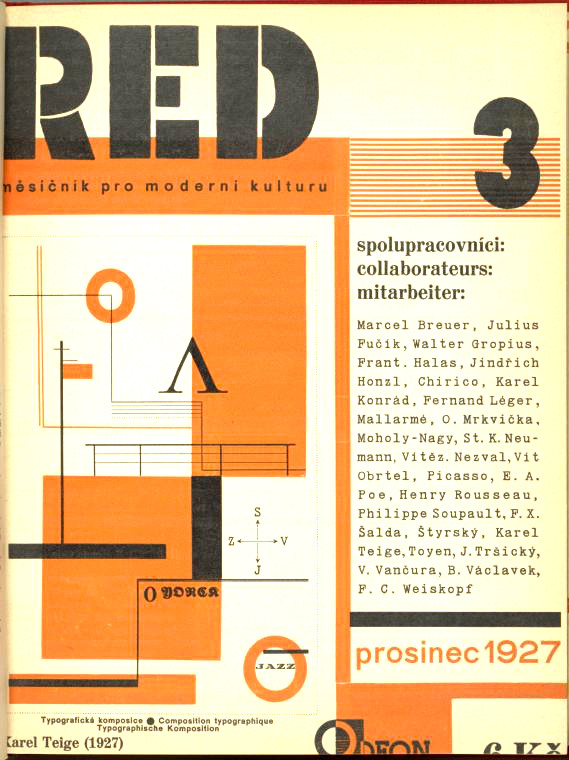
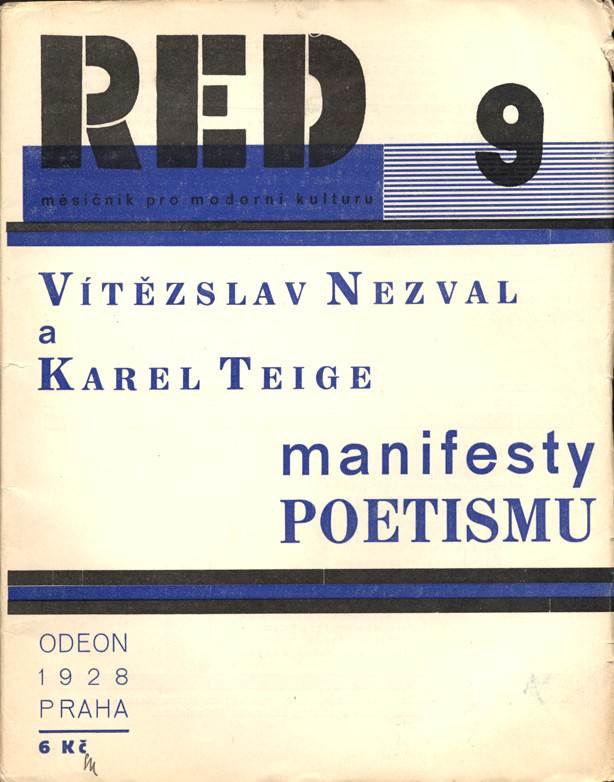
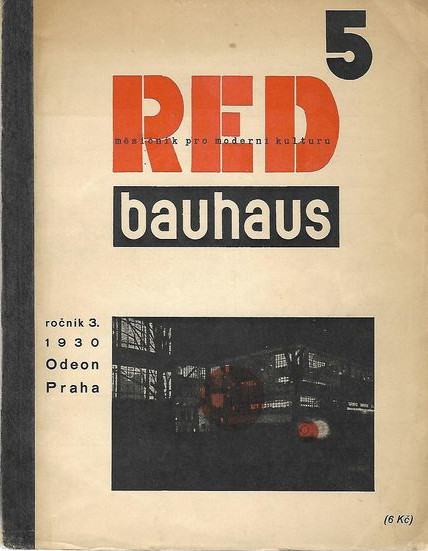
ReD (měsíčník pro moderní kulturu / Revue internationale illustrée de l’activité contemporaine / Internationale Monatsschrift für moderne Gestaltung) was an art magazine published by members of the Czech avant-garde art collective Devětsil.
Thirty numbers were published, with the special issues on the Russian avant-garde, Bauhaus, and photography/film/typography.
Several manifestos appeared in the journal: Toyen and Jindřich Štyrský’s Artificielisme (1:1, 1927), Karel Teige’s second Poetism manifesto [Manifest Poetismu] (1:9, 1928), and the Left Front [Levá fronta]’s founding manifesto (3:2, 1929).
Edited and designed by Karel Teige
Publisher Odeon – Jan Fromek, Prague
via NYPL Digital Library
Each volume in a single PDF (low resolution):
Volume I, 1927-1928 (10 issues, 360 pages)
Volume II, 1928-1929 (10 issues, 324 pages)
Volume III, 1929-1931 (10 issues, 315 pages)
Selected issues in separate PDFs:
The Russian Issue (1:2, Nov 1927)
Foto Film Typo Issue (2:8, Apr 1929)
The Bauhaus Issue (3:5, Feb 1930, partly in German)
JPG pages (search in page annotations):
View online
See also Devětsil: Revoluční sborník (1922), edited by Jaroslav Seifert and Karel Teige, in Czech.
Comment (1)Die Form: Zeitschrift für gestaltende Arbeit (1922-1935) [German]
Filed under magazine | Tags: · advertising, architecture, art, art criticism, avant-garde, bauhaus, city, design, graphic design, industrial design, photography, typography

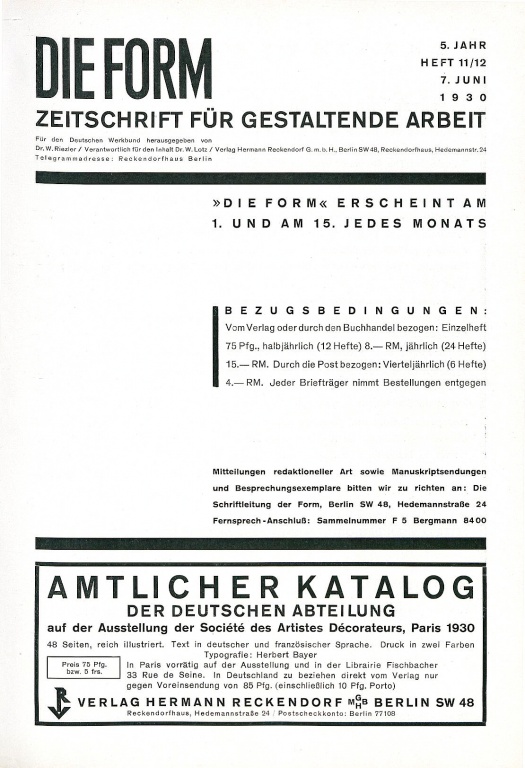

Die in den Jahren 1925-1934 erscheinende Zeitschrift „Die Form“ wurde von Walter Curt Behrendt für den Deutschen Werkbund herausgeben. Sie erschien im Berliner Verlag Hermann Reckendorf; ihre Auflage überschritt nie die Marke von 5.000 Exemplaren. Der Untertitel lautete von 1929 bis 1934 „Zeitschrift für gestaltende Arbeit“.
Bereits im Jahr 1922 hatte es einen ersten Versuch gegeben die Werkbund-Zeitschrift zu etablieren. So heißt es im Geleitwort des ersten Bandes (1925) von Walter Curt Behrendt „Mit dieser Zeitschrift setzt der Deutsche Werkbund ein Unternehmen fort, das bereits vor längerer Zeit begonnen, unter dem Druck der wirtschaftlichen Verhältnisse zunächst wieder aufgegeben werden mußte. Die Zeitschrift wird die Aufgaben der Formgestaltung für alle Gebiete des gewerblichen und künstlerischen Schaffens behandeln.“
Behrendt blieb bis Ende 1926 Herausgeber und wurde dann durch Walter Riezler abgelöst. Die Gestaltung der typographischen Umschläge lag in den Händen von Joost Schmidt. Er war seit 1919 am Bauhaus und leitete seit 1925 die Plastische Werkstatt. 1934/35 wurde die Zeitschrift von den Nationalsozialisten übernommen und dann eingestellt. (Source)
Publishers: Hermann Reckendorf, Munich and Berlin, 1922 & 1927-1932; Kurt Schroeder, Bonn and Berlin, 1925-1926; W. & S. Loewenthal, Berlin, 1933 (1-3); Wendt & Matthes, Berlin, 1933 (4-12), 1934 (1); Deutscher Werkbund, Berlin, 1934 (2-6); Walter de Gruyter, Berlin, 1935
via Universitätsbibliothek Heidelberg
Volumes (single PDFs) and separate articles (PDF, HTML):
Volume 1, 1922 (Die Form: Monatschrift für gestaltende Arbeit, 4 Issues)
Volume 1, 1925-1926 (15 Issues)
Volume 2, 1927 (Die Form: Monatschrift für gestaltende Arbeit, 12 Issues)
Volume 3, 1928 (Die Form: Monatschrift für gestaltende Arbeit, 15 Issues)
Volume 4, 1929 (24 Issues)
Volume 5, 1930 (24 Issues)
Volume 6, 1931 (12 Issues)
Volume 7, 1932 (12 Issues)
Volume 8, 1933 (12 Issues)
Volume 9, 1934 (6 Issues)
Volume 10, 1935 (1 Issue)
Jacques Rancière: Aisthesis: Scenes from the Aesthetic Regime of Art (2011/2013)
Filed under book | Tags: · aesthetics, art, art history, art theory, body, cinema, dance, film, life, literature, music, painting, pantomime, philosophy, photography, poetry, politics, representation, sculpture, theatre, theory
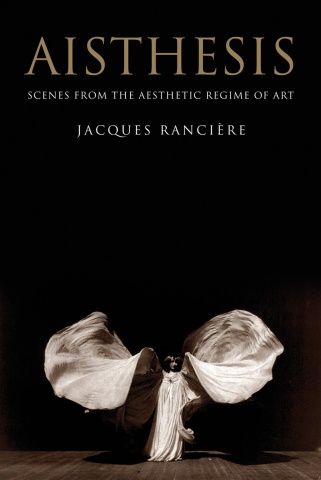
Rancière’s magnum opus on the aesthetic.
“Composed in a series of scenes, Aisthesis–Rancière’s definitive statement on the aesthetic–takes its reader from Dresden in 1764 to New York in 1941. Along the way, we view the Belvedere Torso with Winckelmann, accompany Hegel to the museum and Mallarmé to the Folies-Bergère, attend a lecture by Emerson, visit exhibitions in Paris and New York, factories in Berlin, and film sets in Moscow and Hollywood. Rancière uses these sites and events—some famous, others forgotten—to ask what becomes art and what comes of it. He shows how a regime of artistic perception and interpretation was constituted and transformed by erasing the specificities of the different arts, as well as the borders that separated them from ordinary experience. This incisive study provides a history of artistic modernity far removed from the conventional postures of modernism.”
First published as Aisthesis : Scènes du régime esthétique de l’art, Éditions Galilée, 2011
Translated by Zakir Paul
Publisher Verso Books, 2013
ISBN 1781680892, 9781781680896
304 pages
via falsedeity
Reviews: Hal Foster (London Review of Books), Joseph Tanke (Los Angeles Review of Books), Marc Farrant (The New Inquiry), Ali Alizadeh (Sydney Review of Books), Jean-Philippe Deranty (Parrhesia).
Roundtable discussion with Rancière at Columbia (video, 43 min)
Selected interviews and reviews (in French)

